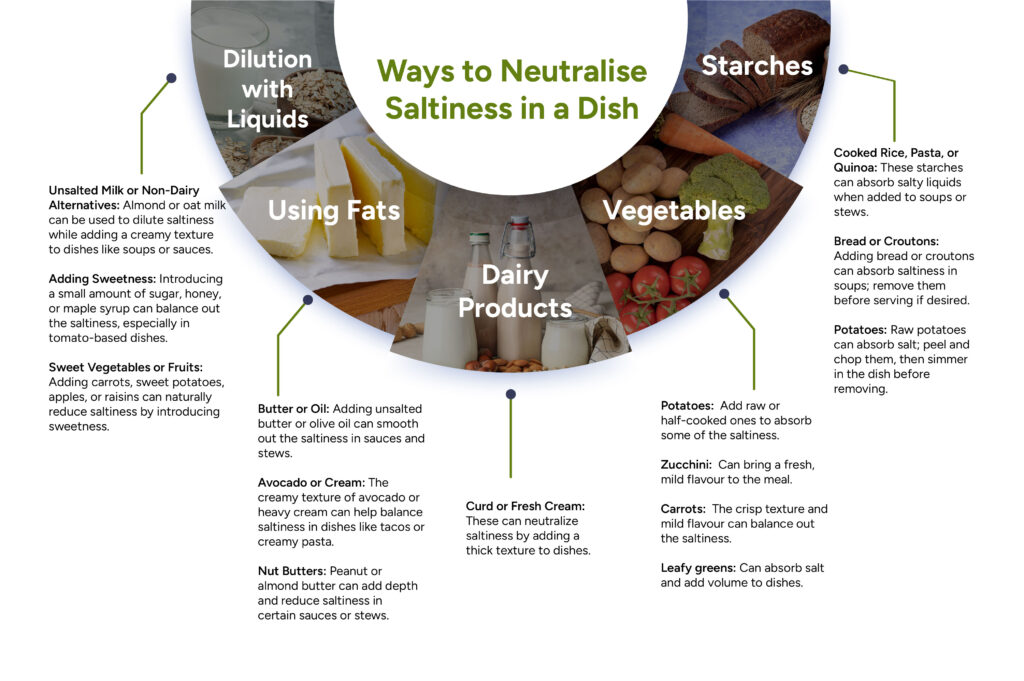Why is Your Food Too Salty?
Before rushing to save your dishes from being thrown away, it helps to know what causes oversalting. The obvious, of course, is adding too much salt. Whatever the reason, even the slightest miscalculation can quickly overwhelm a dish. When dealing with a complex dish with multiple ingredients and steps, salty elements like soy sauce and canned broth can accumulate and naturally contribute to high sodium levels. Meanwhile, reduction techniques like simmering gravies or soups for extended periods can concentrate salt in the dish. In some cases, using the wrong type of salt can make all the difference. Table salt, kosher salt, and Himalayan salt have their uses, and replacing one with another could yield undesirable results.
Ways to Neutralise Saltiness in a Dish
Dilution
Bulk Up the Ingredients
Use Sodium/Salt Reducers
These solutions primarily concern the prepared food industry, providing the desired saltiness while keeping sodium levels down. Salty taste is a huge selling point for packaged foods like namkeen and popcorn. As bad as it may be for the body, salt enhances food’s sensory appeal, and people are wired to enjoy it in moderation. But, it simultaneously raises health concerns that consumers increasingly want to avoid nowadays — sodium reducers give manufacturers convenience and address market demands directly.
Did you know Symega’s TastePro™ Sodium Reduction Tool is a natural solution that can cut sodium levels by up to 30% in snacks, noodles, and more—all while keeping the flavour just as delicious? The product’s advanced flavour technology produces a natural umami sensation that recreates salty sensations without actually using salt. Meet evolving customer needs for varied applications at scale through our scientifically validated product that’s already helped several businesses. Learn more here.
Use Potatoes
When in a bind, look no further than potatoes. Incorporate pieces of partially cooked or raw potatoes into oversalted stews and gravies, and they’ll probably take in some salt while the dish is left to simmer. The potatoes can remain as a way of bulking it up. Or they can be removed to stay true to the recipe’s essence. Is your food too salty? Adding potatoes in addition to dilution helps overcome excess salinity in liquid-heavy dishes, while the quantity is more or less unaffected as potatoes draw some liquid into them.
Mask with Acidity or Sweetness
A drizzle of lime or lemon juice when it comes to meats and fish, a dash of vinegar, or some tomatoes can easily recover oversalted dishes and let the flavours shine. Depending on the flavour profiles, different acidic components can neutralise saltiness in a dish and naturally blend with the dish. For example, distilled white vinegar and rice vinegar are versatile options that go with multiple dishes. In specific instances, apple cider vinegar can be used where sharp, fruity flavours are at play—in marinades and salads.
Similarly, a tiny bit of sugar can be just as effective. Carefully add brown sugar, white sugar, and sweeteners like honey until the desired flavour is achieved.
Creamy Ingredients

Source: Fortune Business Insights
Think Dairy
Tips to Prevent Oversalting
Always Taste as You Cook
Season the Food with Salt Towards the End of the Cooking
Use Unsalted or Low-Sodium Ingredients
Use Measuring Tools
Use the Right Salt
The Takeaway

Source: Fortune Business Insights
FAQs

What are some natural substitutes for salt in cooking?
Natural alternatives include citrus additions such as lemon and lime juice that brighten flavours, particularly in fish and poultry. Various types of vinegar can be used instead of salt, where the tanginess cuts through and sharpens other ingredients. Herbs, whether fresh or dried, can add pungency and depth, similar to salt. Among other choices are ginger, garlic, and spices like chilli.

What are some ways to adjust saltiness in large-batch cooking?
Diluting gravy-based dishes with water or salt-free broth is typically the simplest way to deal with the issue. Right after, simmering the batches and adding herbs and spices will bring the amount to the desired level and consistency while replacing any flavours that may have been lost. Depending on the food, adding acidity (citric acid or vinegar) can help balance flavours and counteract the extra salt in your preparations. Adding spice blends containing sugar to savoury dishes in proportion can also help handle the problem of rectifying large quantities at once.

Does over-salting affect the texture of food?
Salt, especially too much of it, can affect texture. Its hygroscopic nature means it absorbs atmospheric moisture, impacting how foods feel on the tongue. Salt further interacts with proteins in foods in various ways, commonly helping with binding, and additional amounts can lead to undesired results. Additionally, mechanical properties such as dough malleability in baked goods are impacted by salt content, which impacts texture.

Can sugar really balance salty flavours?
Sugar can indeed rescue overly salty recipes. Adding a fraction of brown or white sugar, or even a sweetener like honey, in incremental portions until the flavour is balanced is usually recommended and an easily available solution.


